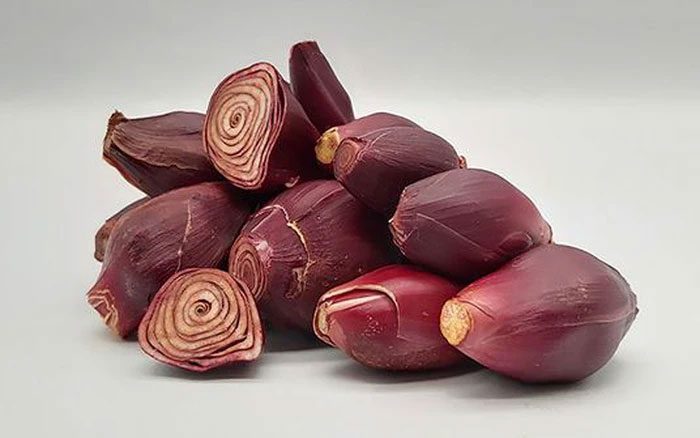Traditional Medicine Practitioner Bùi Đắc Sáng states that red garlic is known by various names, including: Allium sativum, Lao garlic, wild garlic, Phong Nhan, and Hom Búa Lượt (Thai).
Red garlic is a perennial herb that grows to a height of 30-40 cm. Its stem resembles that of an onion but is longer, covered with dark reddish-brown scales, and has a pinkish or reddish-brown interior. The leaves are lanceolate with parallel veins, similar to young palm leaves (sometimes referred to as sâm cau, which shares a name with the plant Curculigo orchioides Gaertn). The flowers are yellow and grow in clusters. The fruit is a capsule containing multiple seeds.
Red garlic is a wild plant that is cultivated for its bulbs (or cloves) for culinary and medicinal use. It is planted using cloves, similar to how onions and regular garlic are cultivated during the winter and spring seasons.
According to Practitioner Bùi Đắc Sáng, red garlic has been found growing wild in Sơn La and Đắk Lắk provinces. It is now widely cultivated in various regions such as Nghĩa Lộ, Hòa Bình, Nghệ Tĩnh, Quảng Nam, Đà Nẵng, and Hanoi. Once the plant has withered, the bulbs are harvested, the outer scales are removed, washed clean, the inner scales are peeled, sliced lengthwise, dried, and used for medicinal purposes.

Red Garlic. (Illustrative image: Internet)
In Traditional Chinese Medicine, the dark reddish-brown outer skin is used medicinally, having a bitter taste, a slightly pungent smell, and a neutral property. Its effects include: antibacterial, anti-inflammatory, blood circulation, detoxification, and it is used primarily for treating sore throat, pneumonia, tonsillitis, and boils.
Many countries around the world also use red garlic for medicinal purposes. For example, in Indonesia, red garlic is used as a diuretic, to treat dysentery, inflammation, and rectal prolapse. In the Philippines, locals use crushed roots to treat bites from venomous fish, insect bites, wounds, and boils. Roasted and crushed red garlic roots are applied to the abdomen to relieve stomach pain. In Peru, indigenous people in the Amazon use red garlic to treat digestive disorders and skin diseases.
Modern scientific studies have found that the total extract of red garlic bulbs in laboratory settings significantly inhibits Streptococcus pneumoniae, hemolytic streptococci, and Staphylococcus aureus, demonstrating both acute and chronic anti-inflammatory effects without causing toxicity.
Red garlic has been shown to increase red blood cell and hemoglobin levels in white rats; it also has a sedative effect, reducing the natural activity of white mice and decreasing their agility.
Practitioner Bùi Đắc Sáng notes that red garlic is used as a blood tonic, treating anemia, jaundice, pallor, dizziness, headaches, and fatigue. It is also used to stop bleeding in cases of hemorrhage, coughing up blood, and bleeding from injuries (using fresh cloves, crushed and applied). Additionally, red garlic is used to treat whooping cough, sore throat, and boils; the dosage is 4 – 12 grams per day, in decoction form.

Red garlic is used as a blood tonic to treat anemia, jaundice…
Some remedies using red garlic:
- For sore throat, pneumonia, tonsillitis: 4g red garlic, 12g Sài đất, 12g Hẹ, 12g mulberry root bark, 12g Bách bộ, 12g Mạch môn. Decoction for drinking.
- For swollen boils: 4g red garlic, 16g Sài đất, 16g dandelion, 16g bougainvillea, 16g Đơn tướng quân. Decoction for drinking.
- Red garlic soaked in “Blood Tonic Wine” for rheumatism treatment: 50g red garlic, 50g Bổ cốt toái, 50g Cẩu tích, 50g Đương quy, 50g Bạch chỉ, 2 liters of rice wine. Soak and consume gradually.
- For anemia, pallor, jaundice, or fatigue: 100g dried sliced red garlic, 1 liter of white wine (30°). Soak for 7-15 days; consume 30ml daily, divided into 2 doses before meals. Continuous use for 15-20 days.
Practitioner Bùi Đắc Sáng emphasizes that while red garlic is not toxic and is relatively safe to use, individuals with a hot blood constitution or allergies should avoid its use.


















































